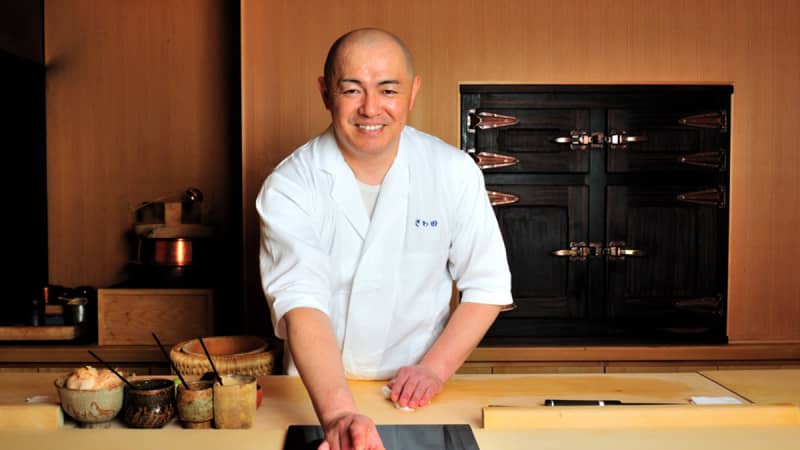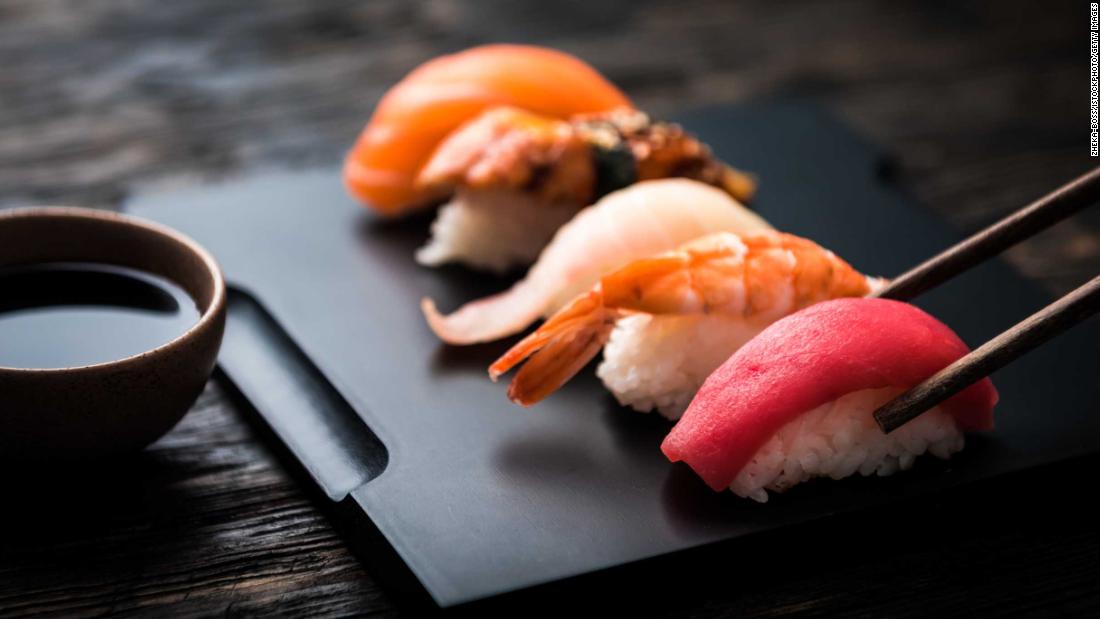Tokyo (CNN) — In theory, sushi is a simple thing to be enjoyed in almost any way you like.
Eat it standing or seated, with fingers or chopsticks, dipped in soy sauce, mixed with wasabi, swallowed in one mouthful or more.
However, if you want to eat it like a Tokyo local, remember that sushi etiquette changes with the setting.
The following tips can separate the uninitiated from those in the know, whether you’re dining at an economical chain restaurant (which is closer to the dish’s street-food roots) or the rarefied establishments of Tokyo’s upscale Ginza neighborhood.
Edomae sushi (Tokyo style), which is what most are familiar with today, is thought to have originated in the 1800s. It typically revolves around nigiri — fish with pressed rice — which can be topped with several dozen types of seafood and other ingredients, not just fish.
Sushi chef training is intense and requires long hours. Chefs often apprentice for several years before they’re permitted to handle pricier cuts of fish.
With that in mind, let’s start at the top: Sushi Sawada, located behind Tokyo’s most prestigious intersection of Ginza 4-chome.
With two Michelin stars and only seven seats, Sawada is a shrine to sushi — and to straight-talking master Koji Sawada’s continuous quest for perfection.
Sawada seasons his ingredients with his own soy sauce blend or a sprinkle of sea salt before combining them on the rice, so he says there’s no need for additional soy sauce to dip.

Koji Sawada’s eponymous restaurant is a shrine to sushi.
Noriko Yamaguchi/CNN
But as the customer is king/queen, Sawada provides sauce on request. He suggests the best way to use it is first to take the sushi and then turn it upside down and dip the fish side.
There’s a practical reason for inverting your sushi: the rice will fall apart if it’s dipped directly. It will also soak up too much sauce, ruining the flavor balance.
The flavor is best if the fish only lightly contacts the sauce.
Then pop it into your mouth.
“The fish should touch the tongue first,” Sawada says.
Most sushi-ya (sushi restaurants) expect customers to dip, and you’ll find soy sauce dishes on the counter. Soy sauce is called murasaki, meaning “purple,” in sushi-speak.
Wasabi moderation and other useful practices
Every sushi-ya will give you a personal o-shibori (hand towel) to wipe your fingers with before eating and between bites.
Alongside the soy sauce will likely be a tub of sweet pickled ginger, known as gari, to refresh the palate.
Use your chopsticks to pick some up and place it on your individual sushi board, called a geta for its resemblance to a wooden clog of the same name.
The chef will normally add grated wasabi, hot Japanese horseradish, to the block of rice as the sushi is pressed.
Feel free to ask for your sushi wasabi-free (“Wasabi nashi kudasai”) if the herb is too pungent for you.
Or alternatively, request more, although be warned that an old-school sushi master may frown if asked for additional wasabi, as he will consider his creation to have the appropriate seasoning.
Again, the customer rules, though be aware that slathers of wasabi are a fair giveaway of a novice, as it will overpower the flavor of the fish.
Furthermore, while wasabi may be mixed with soy sauce to dip sashimi (raw fish without sushi rice), this is not generally done with sushi.
Chopsticks: Pros and cons
There’s something visceral about eating with your hands, and in the case of people who eat sushi, the practice may also suggest a casual and carefree persona. Sawada understands this, and would rather not see his sushi handled with chopsticks — although he provides them.
“Hands are best,” he says. “Like eating curry in India.”
However, at the cheap and cheerful Magurobito (“The Tuna Guys”) in Asakusa, chef Goh Saito says, “Almost everyone these days uses chopsticks. It’s for hygiene.”
Several years ago this writer took some classes with Tokyo culinary instructor Yumi Sone. She says she prefers chopsticks for their elegance, and even finds eating with the hands a little affected when practiced by anyone but a natural.
“But chopsticks can be tricky when dipping sushi upside down,” she agrees.
A further reason to skip chopsticks is that the rice block in the best sushi is often molded quite loosely. Sawada describes his method as packing “a lot of air between the grains.”
It’s what helps create his famous melt-in-the-mouth feel.
Chopsticks can compress loose rice grains and alter the texture, or lose their grip, which could be messy.
Ordering and avoiding faux pas
Many of the best sushi-ya have no menus, but will instead offer different price ranges for fixed courses; your meal is closer to a degustation parade of what’s best on that day.
You can still order individual items, though this will be more expensive.
Rather than lining up a range of sushi, the master will offer each piece as it’s made.
It’s not polite to leave a freshly presented piece of sushi for too long in front of you, as temperature, texture and moisture all change. In this respect the sushi-ya makes more demands of the customer than a typical restaurant — the diner has a role to play.
Feel free to ask for a repeat of anything you especially liked. A common faux pas is when a customer fails to inform the master in advance of dislikes or allergies.
That’s why, when it comes to foreign customers, restaurants such as Sawada or the famed Kyubey, also in Ginza, may ask to speak to your concierge or a Japanese speaker before taking a reservation.
Ingredients that commonly provoke reactions are shrimp (ebi); shellfish (kai) and sometimes uni (pronounced oohni), sea urchin. Some people dislike the “fishiness” of items such as mackerel, sardines and herring, collectively known as “glistening things,” or hikari mono.
Most mid-range sushi-ya offer courses. If the course you choose includes anything you can’t eat, say the name followed by nashi kudasai, “exclude, please”. If you’re unconcerned about budget and only want the best the master has to offer, tell him o-makase shimasu — I’ll leave it to you.
Of course, chain sushi restaurants, usually with conveyor belts, make things easier — most offer photographic menus and you can simply serve yourself.
Better still, take a stool at the counter and this tip from cookery teacher Sone: “I never take a plate that’s going around,” she says. “You can order freshly made, direct from the chefs. Also this way, I can ask for a smaller amount of rice (shari sukuna-meh kudasai).”
This is a common practice among diners who don’t want to fill up on rice.
Many sushi-ya serve in portions of two pieces, but most of the cheaper standing places allow you to order singly.
It’s worth noting the quality at such establishments can be very good, as their turnover is high and many are operated by seafood wholesalers.
Standing places are intimate and delightfully casual. When pushed for time one can eat well and be out within under half an hour.
Check, please
Sushi restaurants in Japan serve green or brown roasted tea at the end of a meal (and throughout, if you prefer it to sake or beer), before the check arrives. The tea is called agari.
Be warned that at many high-grade and traditional establishments, the check may come as no more than a handwritten number on a tiny piece of paper. This is often a shock.
Though the new generation of sushi chefs makes a point of being customer-friendly, a top class sushi-ya can still be daunting, even for natives.
In fact, very few ordinary Japanese get to enjoy sushi at the absolute highest level, so if you’re able to take a local friend along, don’t be surprised to learn it’s their first time, and they are as much in awe of the experience as you.
Sushi Sawada: MC Blg, 3/F, 5-9-19 Ginza, Chuo-ku, Tokyo; Tuesday-Friday, noon-2 p.m. and 6-8.30 p.m.; Saturday, holidays. noon-2 p.m. and 5-7.30 p.m.; Sundays, noon-2 p.m. Closed Mondays. Budget up to around ¥40,000 (lunch); ¥50,000 (dinner); +81 (0) 3 3571 4711
Magurobito (standing-style restaurant): 2-18-12 Kaminarimon, Taito-ku Tokyo; 11-9 p.m., open every day. Budget around ¥2,000-¥3,000. +81 (0) 3 3847 7139
Magurobito (seated restaurant): 1-1-11 Hoshi Building 1F, Asakusa, Taito-ku Tokyo; 11.30 a.m.-10 p.m., open every day. Budget up to around ¥4,000. +81 (0) 50 5868 1438 (reservations) +81 (3) 5828 5838 (inquiries) same restaurant name but two different experiences.
